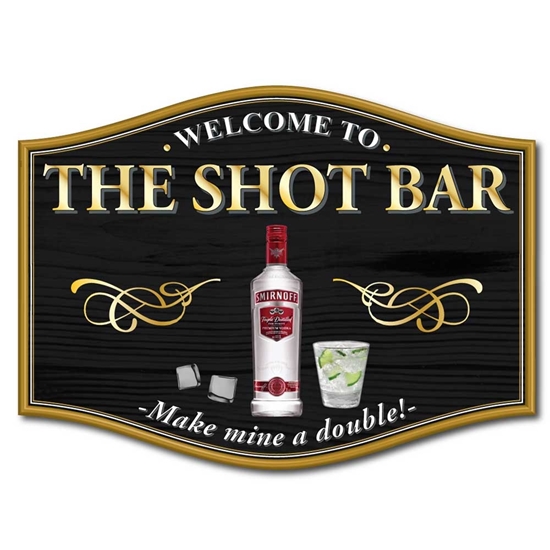Excellent Facts To Choosing Hanging Signs
Wiki Article
What's The Point Of Bar Signs?
Bar signs can differ significantly in terms of function. There are several key differences between bar signs. Branding
The purpose of this program is to strengthen the bar's reputation and identity.
Features: Often includes the bar's logo, name and the signature colors. The design is intended to reflect the style and theme of the establishment.
For example neon signs that have a bar's logo or custom metal signs that feature the bar's name.
2. Information
The aim of this guide is to provide important details for customers.
Features: Clear, clear text with clear information on the hours of operation WiFI passwords, home rules or toilet places.
For instance, a notice at the entrance with hours of operation or pointing to the toilets.
3. Decorate your house with these Decorative Items
Objectives: To improve aesthetic appeal and enhance the ambience of the pub.
Highlights: They are typically artistic or thematic and add to the look of the bar as a whole. You aren't allowed to add text or particular information.
Examples: Vintage advertisements for beer, signs that have a a quirky or humorous theme or themes in artwork.
4. Promotions
The purpose of the campaign is To advertise certain products, specials or special events.
Features: Design that is attractive, and emphasizes special offers, upcoming occasions or menu items. May include temporary or changeable elements.
Examples include chalkboards that feature daily deals, banners for happy hour offers and posters that promote future events.
5. Directional
Use to direct patrons to the appropriate bar.
Features: Use clear arrows to guide customers in the area, for example bathrooms exits, restrooms, and other bars are.
Examples: Signs pointing towards restrooms, "Exit" signs, directions arrows to different seating areas.
6. Regulatory/Compliance
Obligation: Keeping in line with the legal requirements, and ensuring safety.
Features: Necessary signs that meet legal requirements, such as the location of smoking areas, maximum occupancy limits and emergency exits.
Examplesinclude "No Smoking", occupancy limits, and emergency exit signs.
7. Interactive
Intention to connect with customers and create interactive experiences
Features: Tools to increase patron involvement. Examples include write-on surface as well as digital interaction.
Signs equipped with QR codes connect to menus in digital format, social media or other information sources.
8. Thematic
Purpose: To create a specific theme or atmosphere.
Features: Signs that align with the theme of the bar, making a difference to the overall ambience and atmosphere.
Examples: Pirate signs in nautical bars, rustic wooden signs at bars with a rustic theme.
9. Menu
The menu will be displayed on the bar.
Features: Lists clearly the food and beverages, often with prices. Can be static, or can change.
Examples Screens that are digital and display rotating menu items, wall-mounted drinks menus.
Each type of bar sign serves a distinct purpose and is designed accordingly to perform its particular function within the bar environment. Understanding these differences will help bar owners decide on and put up signs to satisfy their needs and improve the experience for their customers. Have a look at the recommended recommended you read for garden bar signs for more info including make your own bar sign, make a bar sign, outdoor home bar signs, hanging home bar signs, home made bar sign, pub signs for home bars, the staying inn sign, personalised garden bar signs, gin bar sign, small pub signs and more.

Durability Of Bar Signposts Varies.
The durability of a bar sign is contingent on a variety of factors, including design, the material used and the intended usage. Here are the main factors that influence bar sign their durability. Material
Metal Signs: Signs made of steel, aluminum or other metals are able to be used outdoors as they are durable and resistant.
Solid Wood Signs: Solid wood signs may require regular maintenance in order to prevent decay or warping, especially when they are used outdoors.
Acrylic: Acrylic signs can withstand outdoor exposure and are durable.
Neon/LED: Neon signs can be delicate and vulnerable to damage, while LED signs last longer and are energy efficient.
2. Weather Resistance
Outdoor Signs: The materials and coatings used for signs that are that are exposed to the elements outdoors should resist corrosion, fading and water damage.
Indoor signs even though they're not exposed to the elements, indoor signage must remain able to withstand temperature, humidity fluctuations, and wear.
3. Construction
Solid Construction: Signs that have robust frames, reinforced corners, and sturdy hardware for mounting are less susceptible to damage.
Signs with sealed electrical components: Signs that have sealed electrical components (for lit signs) are less susceptible to water damage.
4. Maintenance Requirements
Low maintenance: Bar owners will prefer to have signs that require occasional cleaning or a minimal amount of maintenance.
High Maintenance: Signs with intricate designs, delicate materials, or require special maintenance are costly and time-consuming.
5. Location
Indoor signs are usually less prone to environmental hazards. They might also be less durable than outdoor signs.
Outdoor Signs. Outdoor signage needs to be durable. It has to stand up to sunlight exposure, rain or wind and temperatures that fluctuate.
6. Impact Resistance
Signs indicating high-traffic areas or areas where they may be impacted (e.g. crowded bars) must be constructed of durable materials that resist scratching and denting.
Signs with covered surfaces are less vulnerable to damage caused by vandalism, scratches, and spills.
7. Longevity
Durability: Signage that is durable is built to last for years, without significant deterioration. This is a great return on the investment of bar owners.
Short-Term Use: Signs intended for temporary promotions or events do not necessarily need the same endurance as permanent signs.
8. Lighting
Lighting Components. Illuminated signs with neon or LED lighting should use durable, high-quality components that will last.
9. Environmental Impact
Signs made with sustainable or recycled materials are less likely to have an environmental impact, but are sturdy and practical.
10. Customization
Custom Options: Signs that offer customized options may differ in their durability depending on materials and production techniques used.
Durability is a benefit of durability.
Durability: Durable signage requires less frequent replacement and maintenance and maintenance, which can reduce costs over the long term.
Brand Image: Long-lasting, high-quality signs will reflect positively on your bar's image as well as professionalism.
Customer Satisfaction. Signs that are in good condition can enhance the customer experience as well as enhance the atmosphere of the establishment.
Bar owners can pick signs that are sturdy enough to last for years and provides value in their establishments by taking into consideration factors like material, construction, placement, and maintenance. Take a look at the top rated twofb.com bar signs for more examples including home pub signs, novelty bar signs, personalised outdoor bar signs, indoor bar signs, signs for garden bar, pub signs, make a bar sign, personalised outdoor pub signs, hanging pub signs, large bar signs and more.

How Do Bar Signs Differ From Regulations?
The bar sign is subject to different rules and regulations, enforced by local, federal, and state authorities to ensure aesthetic standards, public health as well as compliance with the regulations on zoning, and to protect the public's welfare. Here's how bar signs differ in terms of regulations:1. Size and Placement Regulations
Zoning laws: The regulations regulate where signs are placed, their dimensions, distances, and heights, as well as their distance from property lines, roadways or other structures.
Historical Districts: Restrictions could be in place to protect the historic nature of certain regions, limiting the size, design and materials of signs.
2. Illumination Restrictions
Light Pollution: To try to reduce light pollution, it's possible to limit the brightness, color, and the duration of the signs that are illuminated.
Safety: Signs must not create glare or a distracting light that could cause danger to drivers or pedestrians. This is especially true close to roads.
3. Signage Content
Alcohol Advertising Some jurisdictions restrict alcohol advertisements by preventing certain images or content that may be attractive to minors.
Health Warns: Laws might require health warnings about the risks of drinking alcohol or smoking cigarettes.
4. Historic Preservation Regulations
Architectural Compatibility: Signs within historic districts should be in harmony with the architectural style and character of the region, typically needing the approval of preservation commissions or boards.
Material and Design: Signs that are historically significant may have restrictions on the materials that are used, design and color scheme.
5. Sign Permitting Process
Permits are needed: Owners of bars need permits to put up or alter signs. This can involve submitting drawings, paying fees, as as obtaining approvals from local authorities.
Code Compliance: Signs have to be in compliance with building codes as well as fire safety rules as and accessibility standards in order to protect the public and to ensure accessibility for those with disabilities.
6. Maintenance and Removal of Signs
Maintenance Requirements Bar owners are accountable to keep their signs in good working order, and ensuring they're structurally sound, free of hazards, and compliant with regulations.
Signs abandoned by the owner: Laws can govern the removal of abandoned or dilapidated signs to stop blight from occurring and preserve the beauty of the location.
7. Digital Signage Regulations
Content Restrictions: There are laws that regulate the contents of digital signage. They may ban certain types of content, including offensive images or lights that flash.
Limitations on Operational Signs To reduce visual clutter, laws may restrict the intensity of digital signs, their movement or the frequency at which they change.
8. Penalties and Enforcement
Inspections: Local authorities inspect signs periodically to ensure they're in compliance the rules for signage. They will issue citations when violations occur.
Penalties: Penalties may include fines, court orders, orders for signs to be taken down or modified as well as legal action.
9. Signing Process
Variance applications: Bar owners who wish to change their signage from the rules can do so by submitting a request for a variance. The reason for the variance must be given as well as any negative effects on the public's safety or appearance should be mitigated.
Public Input : Variances can require hearings in the community or involvement from the property owner or business association.
10. Engagement, Community Input and Engagement
Public Consultation - Certain areas include community members in the creation and the implementation of signage regulations through conducting public consultations or surveys.
Community Benefits : Sign regulations could contain provisions to help promote local businesses or revive the neighborhood.
Understanding and adhering to the regulations for signage will allow bar owners to ensure their signs contribute positively to surrounding communities, comply with the legal requirements and reduce the possibility of fines and penalties. Have a look at the top rated my website make a pub sign for more advice including bar signs for garden, hanging pub signs for sale, personalised garden bar signs, large pub sign, garden pub signs, bar signs for home, bespoke bar signs, design your own bar sign, home made bar sign, pub wall sign and more.
